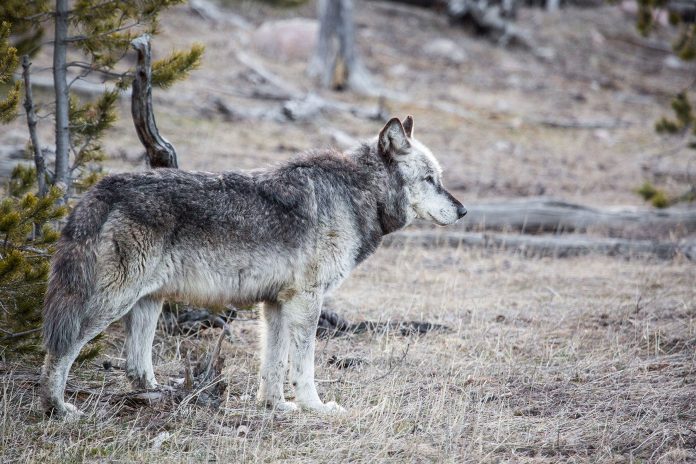Earlier this month, the Idaho Fish and Game Commission approved a plan that will guide the state’s management of gray wolves for the next six years. The unanimous vote came during a regular Commission meeting on May 11. According to the Idaho Department of Fish and Game (IDFG), the “2023-2028 Gray Wolf Management Plan” aims to reduce conflicts with livestock and elk by bringing the wolf population from current estimates of some 1,300 down to approximately 500 individual animals. Idaho’s wolves have been managed by the state since coming off the Endangered Species List in 2011.
“Currently, Idaho has abundant and healthy elk populations statewide, however, herds are unevenly distributed, and eight of Fish and Game’s 28 elk management zones are below objectives,” IDFG stated in a May 15 press release. “In five of those zones, Fish and Game biologists have determined that predation and other factors are limiting herd growth.”
In an attempt to knock back that predation pressure, IDFG hopes to “manage for a stable, self-sustaining Idaho wolf population that fluctuates around 500 animals.” According to the IDFG, the ideal wolf population would reach roughly 650 animals during its reproductive peak in the spring, then dip to 500 in November, and decline to a low of approximately 350 wolves during the late winter months.
How Will the Plan Work?
One way the Commission aims to achieve this goal is by paying hunters and trappers who kill wolves in a handful of targeted game management units where wolf predation and livestock conflict are high. Historically, the department has relied on the help of private non-profits to reimburse wolf hunters for expenditures related to a successful harvest. But with the new plan, IDFG will be anteing up more funds from state coffers to pay hunters back for things like gas, lodging, equipment, and tag fees.
The plan also calls for more lethal removals of wolves by both state and federal agency personnel. And those authorizations could include the “removal of entire packs rather than individual wolves while the wolf population remains above the [stated] goal” of 500, the plan reads.
It’s unclear if Idaho will actually be able to reduce its wolf population to the desired target of 500 animals. A recent survey showed the state’s wolf population has remained stable at around 1,250 wolves despite liberalized hunting and trapping regulations. Because wolves have so many pups each spring, it can be difficult if not impossible for even highly skilled hunters and trappers to keep their numbers in check. In Idaho, this problem is compounded by rugged terrain. The Frank Church River of No Return Wilderness Area, for example—home to much of the state’s wolf population—contains more than 2 million acres of land with no motorized access and only a handful of entry points.
Predictable Opposition
Over the course of 32 days, some 2,500 people commented on IDFG’s new wolf management plan, 75 percent of whom opposed it. Eighteen percent of commenters fully approved of the plan, and 6 percent said they’d approve it with some changes. Commissioner Don Ebert acknowledged the public opposition reflected in those comments.
“I want those people to know I hear what they say, and I take it to heart,” he said. “We’re not going to eradicate wolves. It is not our intention, and I do not believe we would have that ability even if it was our intention. We [want to] preserve, protect and perpetuate species as a whole, and all species in tandem.”
Idaho’s overall population goal of 500 individual wolves was originally set by the U.S. Fish and Wildlife Service in 2009 when the federal agency was attempting to remove wolves from the Endangered Species List (ESL). Similar goals have been set in other wolf states. In Montana, the USFWS set an objective of roughly 400 wolves, while the feds say Wyoming needs to maintain a population of 200 to 300 in order to keep its wolves off the ESL. Wolf advocacy groups say that reducing populations back to these objectives would reverse decades of successful wolf recovery.
Most pro-hunting conservation groups support the states in managing wolves—just like they manage all other wildlife species. The 135-year-old Boone & Crockett Club notes that overly aggressive wolf management approaches could have the unintended consequence of putting western wolves back on the ESL. If a state’s wolf numbers flirt with or even dip below federal thresholds, they could end up re-listed.
“The Boone and Crockett Club supports Idaho Fish & Game’s authority to manage wolves,” B&C’s CEO Tony Schoonen tells Field & Stream. “However, state wolf management is still not secure across the Lower 48. All states and Tribes currently managing wolves must carefully consider how their decisions will be interpreted in Washington, D.C. and whether their actions could jeopardize their state’s ability to keep management of these keystone species.”
Related: Colorado Governor Vetoes Bill That Would Have Slowed the Reintroduction of Wolves
According to Commissioner Ebert, Idaho’s wolves have met and exceeded federal objectives for many years. He says the goal now is to bring the population into a more harmonious balance with prey species—like elk. “I think we need to have the ability to control wolf populations, and I honestly look forward to the day when I can sit here and say ‘I think we need to back off on our wolf harvest,’” he said. “But I don’t think we are there yet.”








